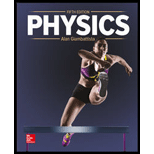
Concept explainers
(a)
The distance between the astronaut and asteroid.
(a)
Answer to Problem 171P
The distance between the astronaut and asteroid is
Explanation of Solution
The mass of the astronaut is
Write the expression to calculate the acceleration of the astronaut.
Here, a is the acceleration of the astronaut, F is the force on the astronaut and M is the mass of the astronaut.
Substitute
Write the expression to calculate the acceleration of the asteroid.
Here,
Substitute
Write the expression to calculate the distance travelled by the astronaut.
Here, x is the distance moved by the astronaut, u is the initial speed of the astronaut and t is the time taken during the application of force.
Substitute
Write the expression to calculate the distance travelled by the asteroid.
Here,
Substitute
Write the expression to calculate the speed of the astronaut.
Here, v is the speed of the astronaut.
Substitute
Write the expression to calculate the speed of the asteroid.
Here,
Substitute
Write the expression to calculate the distance moved by the astronaut for
Here, s is the distance moved by the astronaut and T is the time taken after the force.
Substitute
Write the expression to calculate the distance moved by the asteroid for
Here,
Substitute
Write the expression to calculate the distance between the astronaut and asteroid.
Here, X is the distance between astronaut and asteroid.
Substitute
Conclusion:
Therefore, the distance between the astronaut and asteroid is
(b)
The relative speed between astronaut and asteroid.
(b)
Answer to Problem 171P
The relative speed between astronaut and asteroid is
Explanation of Solution
Both are travelling in opposite direction. Thus the speed with respect one another is the sum of the speed of individual one.
Write the expression to calculate the relative speed between astronaut and asteroid.
Here, V is the relative speed between astronaut and asteroid.
Substitute
Conclusion:
Therefore, the relative speed between astronaut and asteroid is
Want to see more full solutions like this?
Chapter 4 Solutions
Physics
- pls help on thesearrow_forward20. Two small conducting spheres are placed on top of insulating pads. The 3.7 × 10-10 C sphere is fixed whie the 3.0 × 107 C sphere, initially at rest, is free to move. The mass of each sphere is 0.09 kg. If the spheres are initially 0.10 m apart, how fast will the sphere be moving when they are 1.5 m apart?arrow_forwardpls help on allarrow_forward
- 19. Mount Everest, Earth's highest mountain above sea level, has a peak of 8849 m above sea level. Assume that sea level defines the height of Earth's surface. (re = 6.38 × 106 m, ME = 5.98 × 1024 kg, G = 6.67 × 10 -11 Nm²/kg²) a. Calculate the strength of Earth's gravitational field at a point at the peak of Mount Everest. b. What is the ratio of the strength of Earth's gravitational field at a point 644416m below the surface of the Earth to a point at the top of Mount Everest? C. A tourist watching the sunrise on top of Mount Everest observes a satellite orbiting Earth at an altitude 3580 km above his position. Determine the speed of the satellite.arrow_forwardpls help on allarrow_forwardpls help on allarrow_forward
- 6. As the distance between two charges decreases, the magnitude of the electric potential energy of the two-charge system: a) Always increases b) Always decreases c) Increases if the charges have the same sign, decreases if they have the opposite signs d) Increases if the charges have the opposite sign, decreases if they have the same sign 7. To analyze the motion of an elastic collision between two charged particles we use conservation of & a) Energy, Velocity b) Momentum, Force c) Mass, Momentum d) Energy, Momentum e) Kinetic Energy, Potential Energyarrow_forwardpls help on all asked questions kindlyarrow_forwardpls help on all asked questions kindlyarrow_forward
 College PhysicsPhysicsISBN:9781305952300Author:Raymond A. Serway, Chris VuillePublisher:Cengage Learning
College PhysicsPhysicsISBN:9781305952300Author:Raymond A. Serway, Chris VuillePublisher:Cengage Learning University Physics (14th Edition)PhysicsISBN:9780133969290Author:Hugh D. Young, Roger A. FreedmanPublisher:PEARSON
University Physics (14th Edition)PhysicsISBN:9780133969290Author:Hugh D. Young, Roger A. FreedmanPublisher:PEARSON Introduction To Quantum MechanicsPhysicsISBN:9781107189638Author:Griffiths, David J., Schroeter, Darrell F.Publisher:Cambridge University Press
Introduction To Quantum MechanicsPhysicsISBN:9781107189638Author:Griffiths, David J., Schroeter, Darrell F.Publisher:Cambridge University Press Physics for Scientists and EngineersPhysicsISBN:9781337553278Author:Raymond A. Serway, John W. JewettPublisher:Cengage Learning
Physics for Scientists and EngineersPhysicsISBN:9781337553278Author:Raymond A. Serway, John W. JewettPublisher:Cengage Learning Lecture- Tutorials for Introductory AstronomyPhysicsISBN:9780321820464Author:Edward E. Prather, Tim P. Slater, Jeff P. Adams, Gina BrissendenPublisher:Addison-Wesley
Lecture- Tutorials for Introductory AstronomyPhysicsISBN:9780321820464Author:Edward E. Prather, Tim P. Slater, Jeff P. Adams, Gina BrissendenPublisher:Addison-Wesley College Physics: A Strategic Approach (4th Editio...PhysicsISBN:9780134609034Author:Randall D. Knight (Professor Emeritus), Brian Jones, Stuart FieldPublisher:PEARSON
College Physics: A Strategic Approach (4th Editio...PhysicsISBN:9780134609034Author:Randall D. Knight (Professor Emeritus), Brian Jones, Stuart FieldPublisher:PEARSON





